Have you always wanted to buy a safe stock like Coca-Cola (KO) and get rich from it like Warren Buffett?
It’s doable – and I’ll show you how in a minute.
Unfortunately most investors misapply Buffett’s lessons. They “live in the past” and fixate on dividend track records rather than a payout’s forward prospects. And looking ahead is the key to yearly gains of 10%, 15% or even 20% or more with dividend aristocrats.
Let’s consider Coke, which achieved its dividend royalty status in 1987 (its 25th straight year with a dividend hike). The firm hit its coronation with a head of steam, rewarding investors with a 362% payout hike in just five years (from 1986 to 1991). Its stock price raced to keep up with its dividend, rising 234% over the same time period:
Great Dividend Growth, Great Returns

It didn’t really matter if you bought shares before or after the company was officially a dividend aristocrat. The driving factor for profits was the dividend’s velocity – it was moving higher quickly, so its stock price followed.
Fast forward to the last five years, and we see that Coke’s youthful exuberance has slowed considerably. The firm still hikes its payout every year, but it’s a slower climb – totaling 45% over the past five years. Which means its stock price merely plods along too (+25% in five years):
Average Dividend Growth, Average Returns
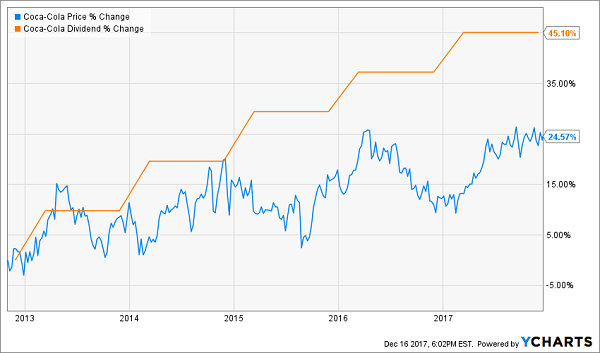
Why is Coke’s dividend slowing down? Simple – just look at the top line.
Shrinking Business is Bad for Payouts
It sounds obvious, but income investors often wade so deep into the dividend weeds that they ignore obvious cues – such as shrinking sales.
Let’s add Coke’s top line into the last chart, and we’ll see that the fact that the payout is growing at all is an act of financial wizardry:
Shrinking Sales Slow the Dividend
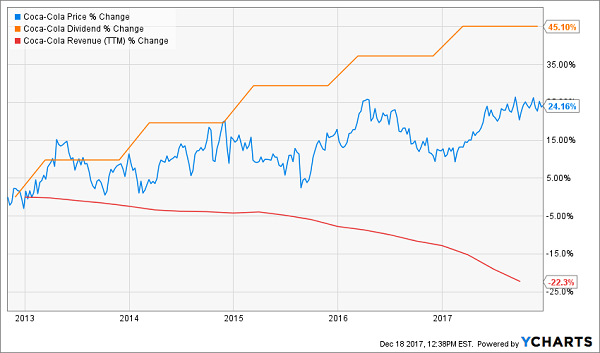
Coke’s top line has shrunk by 22% over the last five years. Which makes its dividend growth quite the feat!
Contrast this with the 1986 to 1991 period, when the company was younger and still growing. It boosted its sales by 30% over that time period.
Of course it’s possible to grow payouts faster than profits and sales. In fact, this is what often happens with dividend payers. But even the most gifted managers can only squeeze so much in payouts from a shrinking pie. It’s better to focus on businesses with the winds at their backs.
And That Can Include Spry Blue Chips, Too
Two years ago I told my Hidden Yields subscribers to buy Boeing (BA) because:
- Its business was booming,
- Its stock was quite cheap with respect to cash flow, and most importantly
- Management was plowing profits into payout growth.
Boeing wasn’t a dividend aristocrat, but it was a better buy than Coke. Here was the tale of the tape in December 2015 (pay special attention to the last column, because it’s the most important):
Boeing vs. Coke (December 2015)

If you want to make real money with stocks, you should always put your money with the faster dividend grower. Boeing was no exception – its two massive dividend raises in the last two years have sent the stock soaring to 124% total returns:
Boeing Soars With Its Payout
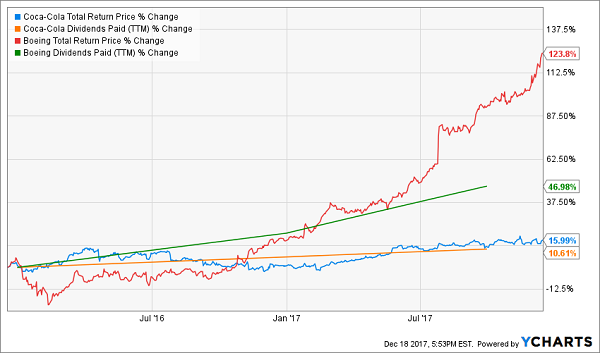
Is the stock on its way to becoming royalty? It doesn’t matter. What matters is that we doubled our money in less than two years on a safe blue chip!
Looking for the next dividend growth double? Let’s look ahead – and put our money with payers that have their best days in front of them.
The Best Industries for Tomorrow’s Aristocrats
Coke’s future business prospects also don’t pass my taste test. Consumers are turning away from its core product of sugary beverages. The company knows this, and is expanding into other segments such as health and energy beverages – but it’s forced to pay up for hot products.
(Which is why I’m actually worried that Coke could be the next GE. It’s following a similar problematic path – a pricey acquisition binge to patch its leaky sales bucket.)
Instead of paying up for past glories, we should instead invest with companies that are generating sales and profit growth organically. From there, we can select the firms that are financially fit enough to dish an increasing amount of their profits back to their shareholders every year.
That’s how you buy the dividend aristocrats of tomorrow right now. And that’s how we double our money every three years or less as we did with Boeing.
What industries should we be looking at today? Here are my three favorites for 2018.
Div Growth Play #1 – “Picks and Shovels” for Chipmakers
There are now more gadgets than humans on Planet Earth – and its unlikely we people will ever catch up. The number of Internet connected devices alone is expected to top 75 billion in just eight years!
Connected Electronic Devices (in Billions)

Source: Statista
Every piece of electronics represented in the bars has its own complex microchip inside. That’s a lot of chips.
The big winners of the electronics boom to date have been, no surprise, the semiconductor chipmakers. The industry at-large grew by 15% in 2017.
My favorite company is perched upstream from the latest “chip rush.” It develops the equipment that microchip manufacturers use to turn their sand into silicon – which actually ends up 1,000 times smaller than a grain of sand itself.
More on this firm in a minute. Let’s talk about more booming tech payouts first.
Future Div Aristocrats #2 – Data Center Landlords
Data center REITs (real estate investment trusts) build “roads” – private data center facilities – for the bustling information superhighway. They then collects tolls by leasing them back to its clients.
These days, more and more devices are online – thanks to these data centers. As a result, demand for these types of facilities is exploding.
Think of these firms as part developer, part landlord. They build, and then sign their clients to long-term leases. Being structured as REITs, they’re required to pay most of its earnings back to shareholders as dividends.
These companies have excellent long-term prospects. With their cash flows growing exponentially, their cash flows should continue to follow. I’ll share my favorite with you in a minute.
Future Div Aristocrats #3 – E-Commerce Real Estate
This asset class is growing just as fast as Amazon. Yet it’s much cheaper and – if you buy right – you can bank a soaring stream of dividends to boot.
“First-level investors” – the basic types who buy and sell off headlines without deeper thought – believe they must purchase Amazon.com (AMZN) itself to profit from the e-commerce boom.
We instead consider what Amazon CEO Jeff Bezos (and other e-commerce entrepreneurs) will need to gobble up themselves to keep their firms growing. By purchasing ahead of their curve, we can then “lease” our asset back to them (at higher and higher rates, of course).
Mark Twain presciently advised readers to invest in land because new supply would be limited. If Twain were advising us today, he’d probably buy warehouses – because they are quickly becoming the most valuable beachfront property in America.
This trend has been gaining steam since the Internet went mainstream. Warehouse demand has enjoyed a non-stop boom thanks to online shopping:
U.S. E-Commerce Sales (in Millions)
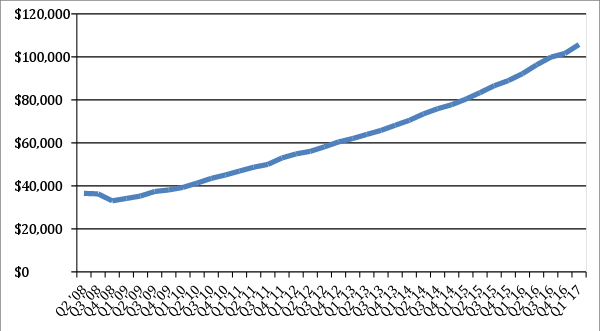
Think about the number of deliveries you receive every week these days. Each package starts in a warehouse somewhere.
The Economist reports that online sellers (including Amazon) will need 2.3 billion square feet of new warehousing to fulfill their increasing order volume. And these firms want their warehouses to be close to big cities (where most of the online orders must be shipped to).
Which means we want to own warehouses in metro areas like these:
Good Places to Own Warehouses
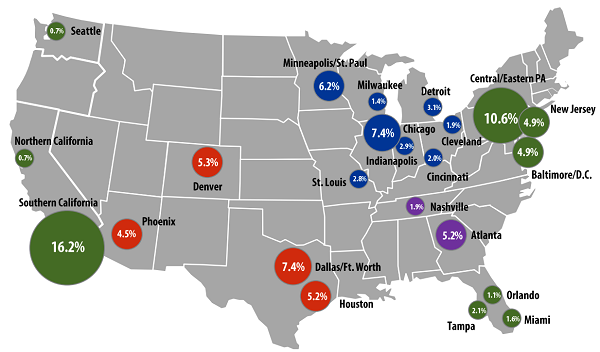
It’s easy to collect growing rent checks (in the form of rising dividends) from this plush real estate. Read on, and I’ll share the stock you’ll want to buy to capitalize on the “Bezos boom.”
3 “Imminent Aristocrats” to Buy Now for 27.4% Yearly Returns
Life is too short to waste our time with middling dividends! Since share prices move higher with their payouts, there’s a simple way to maximize our stock market returns: Buy the dividends that are growing the fastest.
Don’t be fooled by modest current yields. They often don’t capture the growth potential (and it’s the dividend’s velocity that really makes us big money – not its starting point).
How to we buy high velocity dividends, the aristocrats of tomorrow? It’s a simple three-step process:
Step 1. You invest a set amount of money into one of these “hidden yield” stocks and immediately start getting regular returns on the order of 3%, 4%, or maybe more.
That alone is better than you can get from just about any other conservative investment right now.
Step 2. Over time, your dividend payments go up so you’re eventually earning 8%, 9%, or 10% a year on your original investment.
That should not only keep pace with inflation or rising interest rates, it should stay ahead of them.
Step 3. As your income is rising, other investors are also bidding up the price of your shares to keep pace with the increasing yields.
This combination of rising dividends and capital appreciation is what gives you the potential to earn 12% or more on average with almost no effort or active investing at all.
Which future aristocrats should you buy today? Well you know me – I’ve got three best buys – plus four more bonus dividend growth stocks – that should safely double your money every three to five years.
It’s a simple formula – their dividends are doubling every three to five years, which means their prices will rise in tandem. At the same time, we’ll collect their dividend payments today and enjoy an even higher income stream tomorrow.
This dividend growth strategy has produced amazing 27.4% annualized returns for my Hidden Yields subscribers since inception. In two-plus years, we’ve crushed the broader market (the S&P 500 returned 16.1% over the same time period.)
If you achieve returns of 27.4%, you’ll double your money in less than three years. So if you haven’t been following this strategy, why not? The best time to get started is right now – before the seven dividend growers I mentioned begin to move. Click here and I’ll share their names, tickers and buy prices with you right now.

Recent Comments